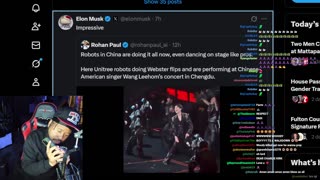Premium Only Content

What is ADVERTISING CAMPAIGN?
✪✪✪✪✪
http://www.theaudiopedia.com
✪✪✪✪✪
What does ADVERTISING CAMPAIGN mean? ADVERTISING CAMPAIGN meaning - ADVERTISING CAMPAIGN definition - ADVERTISING CAMPAIGN explanation. What is the meaning of ADVERTISING CAMPAIGN? What is the definition of ADVERTISING CAMPAIGN? What does ADVERTISING CAMPAIGN stand for? What is ADVERTISING CAMPAIGN meaning? What is ADVERTISING CAMPAIGN definition?
An advertising campaign is a series of advertisement messages that share a single idea and theme which make up an integrated marketing communication (IMC). Advertising campaigns appear in different media channels across a specific time frame that often need to be clearly defined. Modern advertising campaigns often combine multiple online and offline channels such as online social media, TV, OOH media, branded packaging, etc.
A critical part of making an advertising campaign is determining a campaign theme as it sets the tone for the individual advertisements and other forms of marketing communications that will be used. The campaign theme is the central message that will be communicated in the promotional activities. The campaign themes are usually developed with the intention of being used for a substantial period but many of them are short-lived due to factors such as being ineffective or market conditions and / or competition in the marketplace and marketing mix.
Advertising campaigns are developed to achieve a particular goal or a set of goals. Such goals typically include establishing a brand, raising brand awareness, increasing the rate of conversions/sales. The degree of success or failure at reaching these goals is measured with analytic tools. For instance, Google Analytics offers a set of instruments for reviewing and evaluation of online campaigns. There are 5 key points at which an advertising campaign must consider to ensure an effective campaign. These points are, integrated marketing communications, media channels, positioning, the communications process diagram and touch points.
When an organisation begins to construct their advertising campaign they need to research all aspects of their target market/ target consumer. The target consumer is the person or group of people who are most likely to buy from an organisation. A target consumer can be categorized be several key characteristics; Gender, age, occupation, material status, geographical location, behavioural, level of income and education to name the main factors.
Gender is simply whether a person is male or female. Age is usually broken up into bracketed intervals of ten or so years, for example a persons age between 15–25 years old. By understanding which age bracket the target market falls into the advertisers can position their efforts accordingly. Occupation is also known as profession and refers to what a person does for a living; this could be a particular job, student, unemployed etc. A person’s material status defines whether they are married or unmarried. Geographical location is a broad term specifying a particular area or place within a given country, state/ city, suburb or street as some examples. Income refers to home much money a person is earning annually which can help identify how much money they have left over after expenses to potential spend on a brand. The final factor to explain is education, whether a person went to school or not, what school they attended, what standard of education they have, diplomas, certificates, graduate, degrees, masters, PhD’s or other forms of defining educational factors. Knowing this information can help an advertiser understand their target markets level of thinking to help adapt the advertising campaign to be understood by the given target consumer/s.
For a business to successfully find the appropriate Target Market for their products or services, it is important that they segment the market to better decide which customers to target. This is best done when the market is segmented into the four following areas: geographic, demographic, psychographic and behavioural.
Geographic segmentation involves the market being divided into different nations, regions, states, counties, cities, or neighbourhoods. Segmenting the Target market geographically is effective as different areas have different needs, which can be effected by weather, fashion, etc.
Demographic segmentation separates the market into groups according to age, gender, family size, income, occupation, education, religion, nationality, and race. It is important to note that this is the easiest and least expensive way to segment the market, as the research has already been done.
Psychographic segmentation is the process of markets being divided into groups based on social class, personality characteristics, and values.
-
 1:26
1:26
The Audiopedia
1 year agoWhat is MOTTO?
57 -
 4:57:14
4:57:14
Akademiks
6 hours ago21 Savage Wants Young Thug, Wham & Gunna to SQUASH IT! Future Sneak Dissing? Jim Jones Pays 50 Cent?
205K6 -
 6:01:38
6:01:38
Right Side Broadcasting Network
2 days agoLIVE: President Trump to Deliver Remarks in Rocky Mount, NC - 12/19/25
123K57 -
 3:24:48
3:24:48
VapinGamers
5 hours ago $20.39 earnedDestiny 2 - Dungeons and Loot with Friends - !rumbot !music
76.6K1 -
 2:07:44
2:07:44
TimcastIRL
6 hours agoTrump's Secret Plan To Make Charlie Kirk VP, America Fest IN CIVIL WAR | Timcast IRL
206K150 -
 LIVE
LIVE
I_Came_With_Fire_Podcast
14 hours agoLive Fire: Christmas Special
465 watching -
 46:26
46:26
Sarah Westall
8 hours agoWhat’s Behind the Silver Surge? Large Institutions Cashing In w/ Andy Schectman
29.8K -
 6:42:10
6:42:10
Turning Point USA
13 hours agoLIVE NOW: AMFEST DAY 2 - VIVEK, JACK POSOBIEC, MEGYN KELLY, ALEX CLARK AND MORE…
1.26M180 -
 1:14:37
1:14:37
Flyover Conservatives
1 day agoHow to Win 2026 Before It Starts — Clay Clark’s Goal-Setting Blueprint | FOC Show
30.7K1 -
 12:52
12:52
The Kevin Trudeau Show Limitless
2 days agoBeyond Good And Bad: The Hidden Reality Code
69.8K21